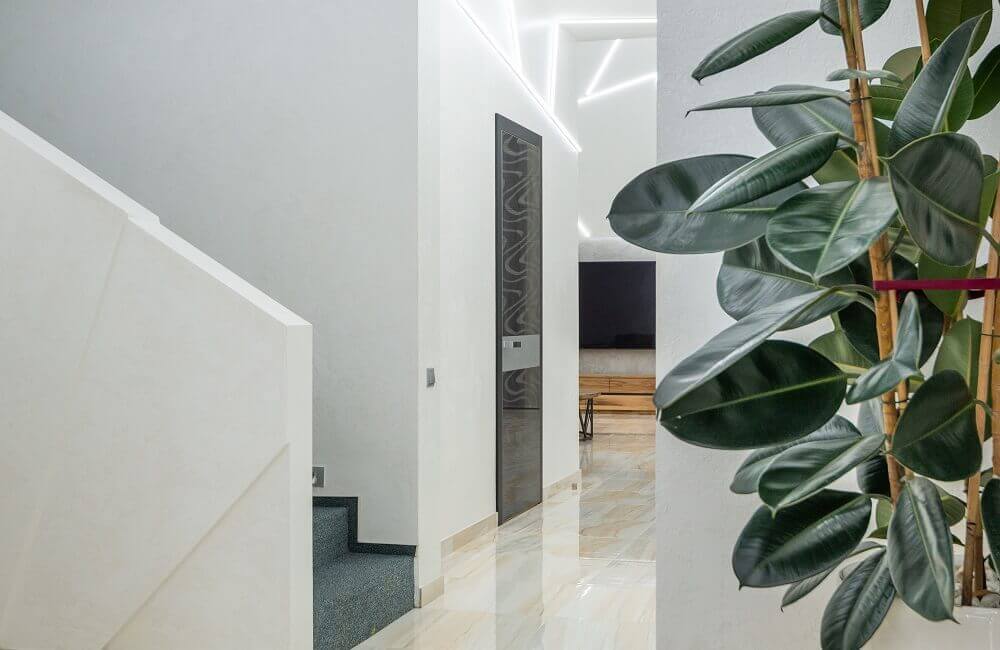
You have fallen in love with the glorious, shiny rubber plant and got yourself one. Now, you are confused about where to exactly keep the plant in your house. Choosing the location of your houseplants is a key decision that can determine how healthy or troublesome their lives are going to be.
Ficus elastica or the rubber plant is native to the tropical regions and thus requires a kind of environment that is closer to its origin. The plant is hardy and can tolerate less-than-ideal situations. However, your rubber plant is also sensitive to change. It can unexpectedly shed its leaves in protest if there are too many changes or shifts around.
Table of Contents
Points to Note When Deciding The Location For Rubber Plant
When you keep a plant, you don’t just want it to survive and make do. You want it to thrive and grow robustly. Similar to how we take care of ourselves in order to be healthy and lead a happy life, even your plants need to be provided with the right conditions to allow them to have a healthy life. There are a few basic sets of requirements that are required to keep in mind while you are choosing the location for your rubber plant. The following are the factors that will determine the ideal place for the plant in your home.
Related: Why Is My Rubber Plant Not Growing? Causes And Solution
-
How Much and What Kind of Light Is Ideal for Your Rubber Plant?
One of the important factors to consider is light conditions. Your rubber plant needs ample bright light but it needs to be in an indirect form. Most often, it is best to keep the plant next to a window or on a window sill, as long as it is protected from direct light. The best location will be the window in the house that receives the indirect morning sunlight and gets exposed to the late afternoon or early evening light.
If the perfect location is eluding your rubber plant, you can decide on a less than perfect location and work on perfecting the lighting condition. You can choose a location with brighter light and diffuse the intensity by using filters like a translucent curtain or a screen to provide the ideal lighting for your rubber plant.
If you are keeping it on a balcony, ensure there is enough shade or protection built to safeguard your rubber plant from the direct rays of the sun.
-
What’s the Best Temperature Range for Your Rubber Plant?
The temperature range that is ideal for your rubber plant rests between 55 degrees and 80 degrees Fahrenheit. See to it that the temperature in the chosen area to keep the plant stays within this preferred range and you will soon see your rubber plant growing healthily.
If you are living in a place where the temperature can get higher than the upper limit during summer, plan on moving the plant to another area during the hot months. This is applicable especially for the rubber plants kept outside like in the balcony area. You will need to get the plant inside when the temperature gets too high for their safety.
On the other hand, if your house is in a colder region, covering your plant to prevent cold and frost is recommended, especially if the temperature dips to 40 degrees Fahrenheit or below. Use sticks or poles and cover the rubber plant with a blanket, ensuring that the fabric does not touch the leaves.
Buying an artificial light to keep the temperature within the required setting can also help to provide a warmer environment for your rubber plant. Another way is burning wood or a furnace to raise the room temperature. In this case, you need to ensure that the plant is kept away at a safe distance to prevent the leaves or other parts of the plant from getting burnt while still providing enough warmth.
-
How Much Humidity Does Your Rubber Plant Need?
Hailing from the tropical region, your rubber plant requires medium to high humidity conditions for the plant to thrive. You can check the humidity of the location to know if the place is suited or not. If the moisture level is not satisfactory in the area but it meets most other conditions, you can increase or decrease the humidity through different methods.
When there’s a lack of moisture, one of the easiest solutions is to group your houseplants together. This will promote humidity around the plants through the transpiration process whereby the leaves release water from their pores and increase the moisture level in the surrounding air.
You can also mist spray your rubber plant to allow greater moisture availability around it. If you are misting, it is best to do it in the early mornings so that your rubber plant has sufficient time to dry before the end of the day. This is to avoid pest infestation or diseases due to too much moisture present on the plant.
In less than ideal situations, using a humidifier can prove to be a great way to ensure the moisture in the air is always at an optimum level. Placing bowls of water can also raise the humidity in the area.
There is also the method of using pebbles and water in a tray. First, fill the tray with enough pebbles and then pour water over it, ensuring the top layer of gravel is not soaked in water. The potted rubber plant can then be placed over the tray, the bottom touching the gravel but not the water.
As with most other houseplants that need higher levels of humidity, the best location in the house is to keep it in the bathroom. The environment in the bathroom of your house promotes high humidity conditions and can be ideal, as long as it is big enough to accommodate the rubber plant. In such cases, extra care needs to be taken so that the soil does not get soggy or becomes too wet. You can place it higher up next to the window or on the window sill.
In case of too much humidity, your rubber plant might become vulnerable to attacks from pests and pathogens causing infections. To allow for greater air circulation around your plant and lower humidity, you can prune some of the leaves and also increase the distance among the plants.
Related: Rubber Plants Water Requirement
Frequently Asked Questions
Can you place the rubber plant near a window?
Keeping your plant next to a window is an ideal place, as long as the window receives ample bright but indirect light.
Is the balcony or patio the right place for the rubber plant?
You can keep your rubber plant in an outdoor area like a balcony, provided the space is not exposed to harsh direct sunlight. A west-facing balcony or patio would be ideal provided there is some kind of shaded protection to filter the light.
How to protect the rubber plant during sudden climate change?
When kept near the window, your rubber plant can become exposed to any sudden cold or heat conditions. Moving the plant, a little further away from the window helps to deal with hot weather or cold days. When it’s too hot, this will prevent burns and damage to foliage and the soil from drying quickly. When it’s too cold, this will avoid the plant from suffering cold or frost damage.
Can you keep the rubber plant in a room with a fireplace?
It is advisable to avoid placing your rubber plant in a room that has a fireplace. The presence of fire can lead to quick drying of the soil and reduce the high humidity level that your rubber plant needs. The heat from the fire can also cause burns and the darkening of your precious rubber plant leaves.
However, if you are living in a colder region, keeping the rubber plant in a room with a fireplace can prove beneficial in keeping the plant warm. Even so, you need to place the plant at least five feet away from the fireplace.
Can you keep the rubber plant in your bedroom?
As long as the rubber plant is getting all its basic requirements of light, temperature and humidity fulfilled, you can keep them in the bedroom as well. Placing it near a window is most suitable for a good amount of bright, indirect light.
Can you keep the rubber plant in a room with the AC?
Yes, there is no issue in keeping your rubber plant in a room with an AC. You need to see that the plant is not placed under the direct line of airflow from the AC. Also, the temperature settings should be within the preferred range of your rubber plant. If you change the settings too many times, it will have an adverse effect on the plant as your rubber plant is sensitive to frequent changes.
Is the rubber plant toxic to pets or humans?
Yes. Rubber plant releases a sap when it is cut, which is toxic and causes skin irritation and further harmful complications if any part of the plant is ingested. Most pets and children might playfully pluck or bite the leaves or other parts of the plant. So, it is best to ensure that the plant is out of reach of pets and children.
References:
https://pss.uvm.edu/ppp/articles/rubberplant.html
https://secure.caes.uga.edu/extension/publications/files/pdf/B%201318_5.PDF

Ranjan Singh Moirangthem is a media professional based in India, currently working as a freelance copywriter. Growing up in a hill station and now living in a concrete jungle, he finds solace in the green corners of the city, be it parks or his housing society garden. He’s even passionate about plants and gardening and shares his experience by writing in-depth and well-researched articles for our readers.
